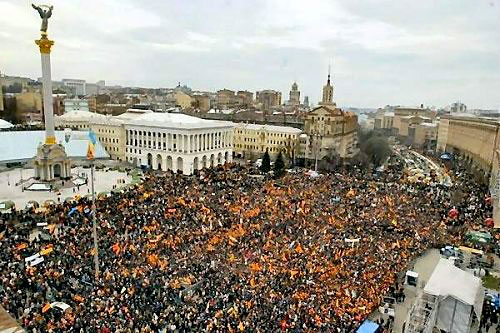Colour revolution
Color Revolutions are unarmed, but not non-violent regime change (regime change) since 2000, which are for a visual identification color or by a generally assessed as positive the plant ( eg, cedar, rose, jasmine ) named.
- 5.1 manuals
States and stakeholders
Color revolutions were in 2003 in Georgia ( Rose Revolution ), 2004 in Ukraine ( Orange Revolution) and 2005 in Lebanon ( Cedar Revolution ) and successfully put in Kyrgyzstan ( Tulip Revolution ). In Belarus, it failed in 2006 after five days.
The official was triggered in the three post-Soviet states Georgia, Ukraine and Kyrgyzstan allegations of electoral fraud. In Lebanon, the anger over the assassination of a former Prime Minister is made to trigger the so-called Cedar Revolution responsible.
The actors of color revolutions are young, most speak excellent English and have studied in Western countries. Your civil disobedience actions were carried out with modern marketing methods and means of communication. During the revolutionary period, the organizers produced daily new messages that have been the locally represented international media conveys and commented with background knowledge. Reports from BBC World, CNN and Al Jazeera had then in each case directly to their own land back and animated hundreds of thousands of people to demonstrations.
Successful color revolutions led to its organizers often for career boost. They took over important positions in the legislative and executive branches. They include the mayor of Tbilisi, Giorgi Ugulava, and the Georgian parliament Giga Bokeria.
In the fall of 2012, a completely new revolution took place in Georgia: the " prison - revolution." This was not a prison revolt, but a triggered by a prison scandal of power. The hitherto leading in polls party "United National Movement " of the President Mikheil Saakashvili suffered by the proliferation of videos about abuse in a Georgian prison such a slump in voter support that they which resulted in the parliamentary elections of 1 October a heavy defeat suffered and the power to run from billionaire Bidsina Ivanishvili opposition movement " Georgian dream" Make musste.Der Caucasus expert Thomas de Waal speaks of a "democratic counter- revolution" through free elections which passed through the Rose Revolution in the power of people to Saakashvili swept away and a new team brought to the billionaire Ivanishvili to the government.
While color revolutions in some countries of Eurasia ( in Ukraine, Georgia and Kyrgyzstan) forced an abrupt shift to more "democratic " conditions, go to Russia changes very slowly without abrupt breaks the right to carry a variety of forms of protest, commitment to the establishment, in the economy and elections. Brian Whitmore of Radio Free Europe used for this process the term " Tortoise - revolution ", which means as much as " turtle - revolution." In Russia, only toughness, suffering and patience would lead to political and social changes.
Origin and distribution
The model supported by a funded non-governmental organizations from the West peaceful change of power in not pro-Western countries was applied for the first time in Slovakia. There the platform občanská wore kampan '98 significantly to the deselection of Prime Minister Vladimir Meciar 1998. In Serbia, the model in replacing Slobodan Milošević was further developed in 2000.
In Georgia, the opposition TV station Rustavi- 2 caused a nationwide spread of Otpor Lessons: A few days before the Rose Revolution, he transferred twice a detailed documentation of the Serbian revolt. The organizers of Otpor have now established an international consulting institute, the Belgrade Centre for Applied nonviolent action and strategy - CANVAS (German Centre for Applied nonviolent action and strategy).
After Serbian pattern color revolutionary youth movements ever played in Azerbaijan ( YOX, dt No), Belarus ( Zubr, dt bison ), Uzbekistan ( Bolga, German Hammer) and Egypt ( Kifaya, dt Enough ) operates. At a meeting in Tirana in June 2005, 80 delegates came together from eleven countries that want to emulate them. YOX strives for a Green Revolution in Azerbaijan, Zubr a cornflower blue revolution in Belarus.
U.S. start-ups and support
A number of investigative journalists and writers such as Ian Traymor, F. William Engdahl and Udo Ulfkotte have since the 2000s after a spiritual, material and logistical support for the color revolutions by U.S. authorities, U.S. security services and US -funded NGOs. Similarly, reported a two -part feature of the German weekly magazine Spiegel in November 2005, on a massive support each local activist groups by U.S. authorities and institutions. There is disagreement, however, in assessing the motivation Mirror journalists about to see in the U.S. activities only disinterested and selfless intentions such as democracy and human rights, and thus assume fully their self-presentation. In contrast Ulfkotte, Engdahl and other journalists throw the U.S. before, with pro-US regime change a New World Order (New World Order ) want to enforce in the sense of George HW Bush's speech on September 11, 1990.
The Washington Post reported that the U.S. began 77 million U.S. dollars in advance of the Yugoslav elections on 24 September. They served, inter alia, to provide the opposition parties computers, fax machines and other office equipment and its members to train for the party work. A New York firm has also raised in Serbia opinion polls. Unions and student groups were given money. The action was closely coordinated with European allies and had been partially processed via Hungary. In addition, a bounty had been propagated in the millions against the candidate Milosevic of the United States.
Financial resources for the payment of coaches and campaign managers of the color revolutions so far has gone mainly from the U.S. and Western Europe. One of the most famous coach is Robert Helvey, a former employee of the U.S. Defense Intelligence Agency. The U.S. foundations Freedom House and National Endowment for Democracy (NED ) and the private foundation Open Society Institute of George Soros put several million U.S. dollars. The meeting in Tirana in June 2005, was financed by the Balkan Trust for Democracy, the Balkan Children & Youth Foundation and the FDP - affiliated Friedrich Naumann Foundation EU-funded. An article in the New York Times in April 2011 confirmed the systematic training of young people through U.S. institutions. A meeting in 2008 in New York City was named for Egyptian activists, which was supported by Facebook, Google, Columbia Law School and the State Department.
Organizations
In the 20th century the U.S. government sat at regime change on the cooperation of the CIA, USAID and other U.S. agencies with local collaborators since 2000 in Serbia primarily assume non-governmental bodies (NGOs ) the organization of the color revolutions. Particularly active and a leader in this respect Freedom House and National Endowment for Democracy (NED ) and funded by George Soros NGOs, especially the Open Society Institute.
Techniques
The central agent is the selection and training of small groups, mostly young people without their own family. Communication takes place in the current crisis situation on prepaid mobile phones for the purpose of faster and more flexible formation of groups of protesters (Flash Mob ), in the second half of the 2000s, increasingly via the Internet, especially via Facebook and Twitter pseudonyms and mobile movies on YouTube. In order to escape the monitoring of Twitter and Facebook in Libya, insurgents used hidden messages on wedding portals on the Internet to convey about how many gunmen to stay with them straight. With the permanent occupation of the main square in the capital respective maximum public is possible.
Survey
Below is a list of protests and uprisings that have since been described by international media as a color revolution, regardless of their output.
- 2000: Bulldozer Revolution in the Federal Republic of Yugoslavia
- 2003 Rose Revolution in Georgia
- 2004 Orange Revolution in Ukraine
- 2005: Cedar Revolution in Lebanon
- 2005 Tulip Revolution in Kyrgyzstan
- 2007: Saffron Revolution in Myanmar
- 2010-2011: Jasmine Revolution in Tunisia










